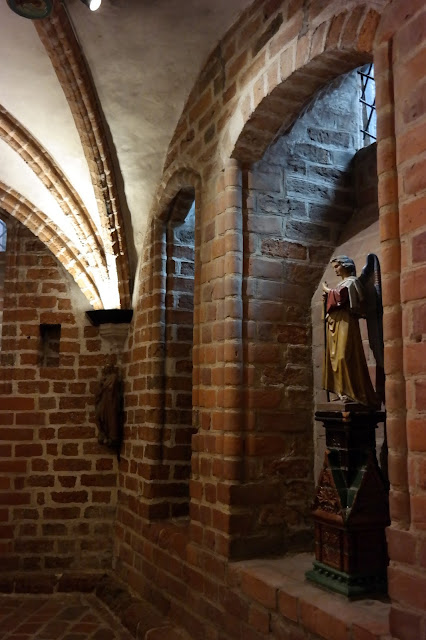Hello again!
I arrived in Luneburg on Thursday, October 22nd in the afternoon. I had been in contact with the monastery by email, so they were expecting me. Upon my arrival, I was greeted by a woman named Charlotte who actually works as a translator and her English was outstanding! I was extremely thankful for that!
 |
| Around Kloster Lune |
 |
| A beautiful window at the entrance of Kloster Lune |
 |
This is the inside of that same window, just inside the kloster.
The fountain has been there since the 1500s! |
 |
| Kloster Lune in all its majesty. |
 |
| Kloster Lune |
 |
| Kloster Lune |
Charlotte gave me a tour of the entire monastery, and then showed me to the museum. Kloster Lune was originally established in the twelfth century, but burned down and was rebuilt in the fourteenth century.
The museum was actually closed, but she let me in and I had the place all to myself! I took hundreds of photos of all of the embroideries, using the lenses and techniques from Volker. It was absolutely incredible, and I sat in awe for a while just thinking about the fact that I am here with all of the textiles I have studied for so long. And I thought about the women who made them 500-600 years ago: all the hours and effort, the technique, the valuable materials, the magnitude of what they did. Truly impossible to put into words.
Most of the embroideries at Kloster Lune are made from colored wool on linen cloth using a stitch known as "klosterstich"-- so-called because it was the stitch most commonly used in the monasteries. It is a form of top-side couching that gives maximum coverage without wasting much thread on the backside of the cloth. There is also another type of embroidery at Lune, called the Fastentucher or Hungertuche. These are white-on-white embroideries used to hide the altar during Lent. The name(s) basically mean "fasting cloth" and the idea is to deprive the senses (of color) and to hide the altar from view as sacrifical elements during Lent. These are amazing as well, and they are a little older than the colored embroideries.
 |
| This embroidery (from ca. 1500) would have hung above one of the choir stalls-- See the Nativity, Resurrection, and Christ in Judgement |
 |
| Detail of the Resurrection |
 |
| Detail of Christ in Judgement |
 |
Here is one of the Fastentuch (ca. 1300-1325)-- White on white embroidery used during Lent.
Christ in Judgement in the top register, and the Crucifixion in the bottom register. |
 |
| Detail of the Crucifixion (with the Virgin Mary and St. John) |
 |
Detail of Christ in Judgement (the four animals around him are the four Evangelist in their heavenly form)
Matthew is the man, John is the eagle, Mark is the lion, and Luke is the ox. |
And so after spending hours in the museum, I stayed the night in the monastery. My room was wonderful, and outfitted with all modern necessities (electricity and a shower!). In the morning, Charlotte introduced me to the two conservators at the monastery. I was already familiar with both of their books, so they were basically celebrities to me! Charlotte helped translate so I could talk to them about my research, and explain that I would be living nearby for the next year. Wiebke (prononced VEEB-kuh) and Tanja (TAHN-yuh), the conservators, were extremely helpful and welcomed me back anytime I am in Lueneburg! They even showed me some of the medieval textiles they are currently restoring!! Such a lucky day!
For the afternoon, I left the monastery and went to old-town Lueneburg. The old town is famous and there are two beautiful medieval churches there! First, I visited Johanniskirche (St. John's Church). The organs there are very famous, and they play them all day so visitors can hear the church filled with the sounds of the organ! It was overwhelming in the best way possible! The architecture was absolutely incredible. I even talked to the man who was working the gift shop, who couldn't wait to tell me he had taken some English classes in the evening at the community center in town! Very cool!
 |
| Johanniskirche, Lueneburg |
 |
Johanniskirche, Lueneburg
|
|
 |
| Johanniskirche, Lueneburg-- Altarpiece ca. 1430-1485 |
|
 |
| Johanniskirche, Lueneburg-- Side aisle altar, ca. 1507/508 |
|
 |
| Johanniskirche, Lueneburg-- Candle-holder, ca. 1490 |
|
 |
Johanniskirche, Lueneburg
|
|
 |
| Johanniskirche, Lueneburg |
|
 |
| Johanniskirche, Lueneburg-- 19th-century stained glass windows |
|
Next, I visited St. Nikolais. Also an amazing feat of architecture! I almost skipped on Nikolai because I had to catch a train, but I am so glad I squeezed it in! It is a beautiful building, and again I spoke to the woman at the gift shop. We were actually able to have a full (albeit simple) conversation!
 |
| St. Nikolai, Lueneburg |
After wandering around Lueneburg for a bit, it was time to catch my train to Wienhausen! I will write about Wienhausen next. I can't wait to share all my adventures! Thanks for reading along and looking at my pictures!




























Oh my gracious. I bet sitting in awe was such a wonderful and quiet moment that you very much deserve. I would have been crying because I'm a mess. I miss you so much! Everything looks absolutely beautiful. I can't wait to open one of your entries and it is all in German. I can tell you're picking it up quickly!!
ReplyDeleteGarrett and Jeremy are playing hockey right now. (6 AM on Friday morning) ha!
I want to skype soon! Whenever is best for you. Let's orchestrate a time. I love you and am so proud of and happy for you!!!!
-samwise